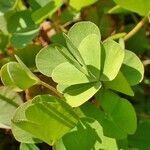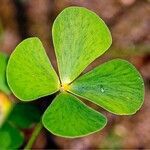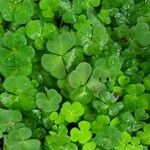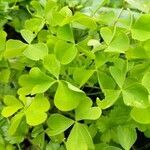Plants forming diffuse clones. Roots arising at nodes and 1--3 on internodes. Petioles 5.4--16.5 cm, sparsely pubescent to glabrous. Pinnae 7--21 × 6--19 mm, sparsely pubescent to glabrous. Sporocarp stalks ascending, frequently branched, attached 1--12 mm above base of petiole; unbranched stalks or ultimate branches of stalks 3--16 mm; common trunk of branched stalks 1--4 mm (rarely 2--3 unbranched stalks attached separately to same petiole). Sporocarps perpendicular to ascending, 4--5.6 × 3--4 mm, 2.3--2.8 mm thick, rounded, oval, or elliptic in lateral view, pubescent but soon glabrate; raphe 1.4--1.9 mm, proximal tooth usually absent, distal tooth absent or 0.1--0.2 mm. Sori 10--17.
Rhizome rooting between as well as the nodes; petioles to 30 cm; lfls glabrous or nearly so, those of emergent lvs 7–30 mm long and wide, those of floating lvs avg a little larger; peduncle attached 1–12 mm above the base of the petiole, 3–20 mm, simple or often branched 1–4 mm above its base to bear 2 or 3 sporocarps; sporocarp 4–5.5 × 3–4 mm, 2.5 mm thick, hairy when young, soon glabrate, the inferior tooth mostly wanting, the superior one wanting or to 0.2 mm; sori 10–17 per sporocarp, with ca 12 microsporangia and 3–7 megasporangia per sorus. In quiet shallow water; native of Europe, locally escaped and established in our range.
A long crawling fern. It can float on water. It has slender creeping rhizomes. It forms roots at the nodes. The young leaves are downy but become smooth. There are 4 triangle shaped leaflets. Each one is 1-2 cm across. The stalks are slender and 15 cm long. The sori or spore bodies, are narrow and enclosed by fronds.






